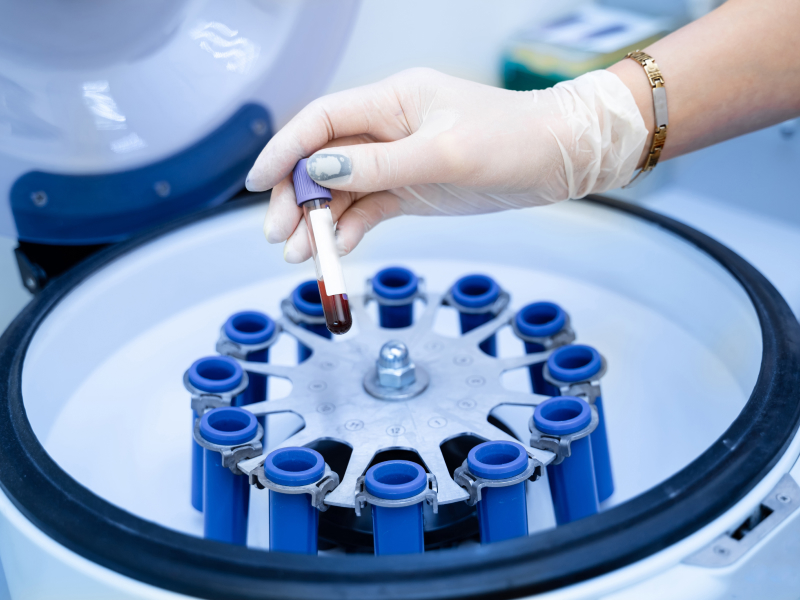In the realm of regenerative medicine, there are three types of injection therapy, each of which offers a unique approach to healing and tissue regeneration: MFAT, PRP, and Prolotherapy.
These treatments are gaining traction for their potential to treat a variety of conditions – from joint pain and sports injuries to musculoskeletal conditions. Regenerative medicine offers promising alternatives to traditional methods, but what’s the difference between these injection therapies? In this article, we break them down for you and interview Dr. Ryan Wood of NW Regen, a specialist in regenerative medicine to explain what makes each treatment unique.
Three Types of Injection Therapy
Understanding the differences between these treatments can be challenging. They each have their own mechanisms, applications, and potential side effects.
- MFAT, or Microfragmented Adipose Tissue, utilizes adipose-derived stem cells.
- PRP, or Platelet-Rich Plasma, leverages a patient’s own platelets.
- Prolotherapy stimulates the body’s healing response with an irritant solution.
This article aims to shed light on these differences. By comparing MFAT, PRP, and Prolotherapy, we hope to help you make informed decisions about your healthcare options.
Understanding Regenerative Medicine
Regenerative medicine focuses on repairing or replacing damaged tissues.
The field includes a wide range of techniques and therapies, but basically leverages the body’s natural healing processes to promote recovery. This approach to medicine opens new possibilities for treating various conditions without invasive surgery.
Regenerative medicine aims to restore normal function and structure in affected areas. This discipline holds promise for offering more effective and personalized healthcare solutions, by using a patient’s own cells, biomaterials, and molecules to stimulate tissue regeneration.
What is MFAT (Microfragmented Adipose Tissue)?
MFAT stands for Microfragmented Adipose Tissue, a cutting-edge therapy that involves extracting and processing fat tissue to harness its regenerative potential.

MFAT injections use the body’s own adipose-derived stem cells to aid in healing.
The MFAT procedure begins with a mini-liposuction to collect fat cells. These cells are then carefully processed to preserve key components. The resulting solution is injected into the targeted area to encourage tissue repair.
MFAT is known for its unique properties. It provides a supportive matrix for tissue repair, thanks to its fat tissue structure. Here are some key points:
- Source: Patient’s own fat tissue
- Function: Supports tissue regeneration
- Applications: Treats osteoarthritis and soft-tissue injuries
MFAT is also considered a form of stem cell therapy. However, it’s important to note that research is ongoing to better understand its long-term effectiveness.
What is PRP (Platelet-Rich Plasma)?
PRP, or Platelet-Rich Plasma, is another fascinating injection technique in regenerative medicine. This therapy leverages the healing properties of your own blood components.

PRP uses your blood to accelerate recovery and reduce inflammation in injured tissues.
The process begins with drawing a small amount of the patient’s blood. This sample is then placed in a centrifuge, which concentrates the platelets. These platelets are rich in growth factors crucial for healing.
PRP injections are versatile and widely used. They are found effective in orthopedics, in aesthetics medicine, and also in dentistry. Below are some important aspects:
- Source: Patient’s blood
- Function: Enhances healing and reduces inflammation
- Applications: Used in sports injuries and cosmetic procedures
PRP therapy has gained popularity among athletes for its potential to reduce recovery time.
Scientific studies continue to examine its efficacy across different conditions. Understanding patient-specific needs is crucial when using PRP, as variations in platelet concentration can influence outcomes.
What is Prolotherapy?
Prolotherapy stands out as a unique technique among injection types. It involves injecting an irritant solution to stimulate healing in damaged tissues.

The goal Prolotherapy is to initiate the body’s repair process through a controlled inflammatory response.
The Prolotherapy technique offers a non-surgical option for patients that has been in medical use for more than a century. Patients with chronic pain in ligaments or tendons often seek Prolotherapy. It’s a favored option when other non-surgical treatments haven’t provided relief.
The most common irritant used in Prolotherapy is a dextrose solution. Once injected, it prompts the body to strengthen and repair weakened ligaments and tendons.
Key elements of Prolotherapy include:
- Main Ingredient: Dextrose solution
- Mechanism: Stimulates mild inflammation for tissue repair
- Ideal For: Chronic ligament and tendon pain
The mild inflammatory response Prolotherapy induces is integral to its effectiveness, gradually leading to strengthened tissues and pain relief.
Comparing Techniques: MFAT / PRP / Prolotherapy
Understanding the differences between MFAT, PRP, and Prolotherapy is crucial for choosing the right treatment. Though each technique aims to promote healing, their approaches vary.
- MFAT focuses on using adipose-derived stem cells extracted through a liposuction procedure. These cells provide a scaffold for tissue regeneration called extracellular matrix (EMC). You can think of ECM as the tissues between your cells (or the mortar between your bricks). It is what holds your cells together, providing structure for your body to heal.
At NW Regen, we choose to harvest regenerative stem cells from your MFAT instead of from your bone marrow because stem cell concentrations from MFAT are roughly 500-2,000X higher than those from bone marrow! And MFAT contains extracellular matrix (ECM) or the connective tissue scaffolding described above, which bone marrow does not. - In contrast, PRP therapy derives benefits from concentrated platelets that release growth factors, enhancing recovery.
At NW Regen, we begin with a simple blood draw processed in our in-office lab under highly specialized protocols to produce platelet-rich plasma (PRP) tailored to you. Then administer a PRP injection directly to the painful area to promote repair and healing, using precise ultrasound to visually guide the injection. Platelets form the first line of defense in response to tissue damage. They contain α-granules rich in growth factors and cytokines that promote tissue regeneration, healing and repair. - Prolotherapy involves injecting an irritant to trigger a healing response. At NW Regen, the irritant is a dextrose solution. This method relies on the body’s natural repair mechanisms by initiating a mild inflammatory process.
Despite these differences, all three methods are minimally invasive and utilize the body’s healing capabilities. Selecting between MFAT, PRP, and Prolotherapy often depends on the injury type and patient preferences.
Each therapy boasts unique benefits, effectiveness levels, and potential applications, making thorough consultation with a healthcare provider essential before proceeding.
Applications and Effectiveness of Different Injection Therapies
Each injection type offers unique applications. In summary, here is a breakdown of these techniques highlights and what each is used for in regenerative medicine.
Overall, the effectiveness of these treatments varies based on the condition and patient-specific factors, highlighting the need for personalized medical advice.
MFAT

How it Works: Uses adipose-derived stem cells, harvested via liposuction, creating a tissue repair scaffold.
Benefits: Gaining recognition in treating osteoarthritis and soft tissue injuries. Its stem cells’ regenerative properties make it versatile.
PRP

How it Works: Utilizes platelet concentration from blood, providing growth factors for tissue recovery.
Benefits: It excels in accelerating healing and reducing inflammation, making it popular among athletes. Frequently used in orthopedics, cosmetic procedures, and dental treatments.
Prolotherapy

How it Works: Employs an irritant solution to stimulate mild inflammation and tissue strengthening.
Benefits: Often chosen for persistent ligament and tendon injuries. It works well for chronic pain by strengthening connective tissues through its irritant solution.
Potential Side Effects and Risks
All three treatments—MFAT, PRP, and Prolotherapy—are considered minimally invasive and generally safe. However, they carry potential risks, like any medical procedure. Most side effects are mild and temporary. It’s crucial to consult a qualified healthcare provider to ensure these procedures fit your medical profile.
- MFAT may cause pain or swelling at the injection site. Since it involves liposuction, there’s a slightly higher risk of infection or bruising. Proper post-care reduces these risks significantly.
- PRP and Prolotherapy have similar side effects, such as mild discomfort and swelling. Some patients may experience a temporary increase in pain.
Cost and Accessibility
The costs of regenerative treatments like MFAT, PRP, and Prolotherapy can vary widely. And insurance coverage for these treatments is inconsistent, with many considered experimental or non-standard.
- MFAT is often more expensive due to the complexity of the procedure and specialized equipment required.
- PRP and Prolotherapy are generally more affordable and accessible.
Choosing the Right Injection Therapy for You
Choosing the best regenerative therapy requires a thorough understanding of your condition. Your preferences and medical history also play crucial roles in determining the most appropriate option. Consulting with a healthcare professional experienced in these treatments is essential.
Regenerative Medicine: What’s the Future Hold?
The field of regenerative medicine is rapidly advancing, offering new hope for patients seeking alternatives to surgery. Emerging research and clinical applications continue to expand the possibilities of these therapies.
As understanding deepens, treatments like MFAT, PRP, and Prolotherapy may become more refined and accessible, revolutionizing how we approach healing and recovery.
NW Regen
We offer regenerative and interventional medicine – tailored to empower you with a more vibrant, active lifestyle.


